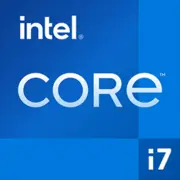Intel Core i7-2635QM

Intel Core i7-2635QM in 2025: Is it Worth Considering an Outdated Processor?
Introduction
Intel Core i7 processors have always been associated with high performance, but time is relentless. The model i7-2635QM, released in 2011, today seems like a relic. However, in 2025, such chips can still be found in used laptops or outdated workstations. Let’s find out who might find this CPU useful today and what compromises they may need to make.
1. Architecture and Process Technology: Sandy Bridge in Detail
The codename of the processor is Sandy Bridge, the second generation of Intel Core. This was a revolutionary architecture that first integrated the CPU and GPU on a single chip.
- Cores and Threads: 4 cores, 8 threads thanks to Hyper-Threading.
- Clock Frequencies: Base clock is 2.0 GHz, maximum Turbo Boost frequency is 2.9 GHz.
- Integrated Graphics: Intel HD Graphics 3000 with a frequency of 650–1200 MHz. For its time, this was groundbreaking, but today even budget graphics cards like the Intel UHD Xe are ten times more powerful.
- Process Technology: 32 nm. In comparison, modern Intel chips (e.g., Core i7-14700H) use 7 nm technology, which reduces power consumption and increases transistor density.
Architectural Features:
- Support for AVX (Advanced Vector Extensions) for accelerating computations.
- Built-in memory controller for DDR3-1333/1600.
- Lack of support for modern standards: PCIe 3.0, USB 3.1, Thunderbolt.
2. Power Consumption and TDP: Price for Performance
TDP (Thermal Design Power) of the i7-2635QM is 45 W. This is a typical value for mid-range mobile processors of the 2010s, but in 2025, such figures are considered high.
- Heat Dissipation: Laptops with this CPU require large cooling systems. Under load, the fans operate loudly.
- Comparison with Modern Alternatives: For example, the Intel Core i5-1340P (28 W, 12 cores) or AMD Ryzen 5 7640U (15–28 W) demonstrate twice the performance with less heating.
3. Performance: Real Tasks in 2025
Geekbench 6:
- Single-Core: 405 (for comparison, Apple M2 — 2600).
- Multi-Core: 1190 (AMD Ryzen 5 7640U — 8500).
Office Work:
- Basic tasks (Word, Excel, browsing with 10 tabs) are handled without issues, but there are delays when opening heavy PDFs or online presentations.
Multimedia:
- Converting video to 1080p will take 3–4 times longer than on a modern CPU.
- Watching 4K video is possible only with hardware acceleration, but many streaming services (Netflix, YouTube) already do not support old codecs.
Gaming:
- The integrated HD Graphics 3000 can only handle games from the 2010s at low settings: CS:GO — 25–30 FPS (720p), Minecraft — 40 FPS. Modern titles like Cyberpunk 2077 or Hogwarts Legacy are inaccessible.
Turbo Boost:
- In turbo mode, the frequency increases to 2.9 GHz, but due to overheating, this occurs briefly. In laptops with poor cooling, the effect is barely noticeable.
4. Use Scenarios: Who is the i7-2635QM Suitable for in 2025?
- Basic Tasks: Email checking, document work, Zoom conferences.
- Second-Hand Market: Laptops with this CPU sell for $150–250 (used). This is a viable option for students or as a temporary solution.
- Retro PC Enthusiasts: For running old games and software that do not require modern APIs.
Not Suitable for:
- Modern gaming, video editing, working with neural networks.
5. Battery Life: How Long Will the Battery Last?
- Operating Time: Laptops with the i7-2635QM were equipped with batteries of 45–60 Wh. Under moderate load (web browsing) — 3–4 hours. Under maximum load — less than 1 hour.
- Power Saving Technologies:
- Intel SpeedStep: Dynamic frequency adjustment.
- C-states: Turning off unused cores.
- However, modern processors (e.g., Intel E-Core) manage power consumption at the individual core level, which is more efficient.
6. Comparison with Competitors
AMD FX-8800P (2015):
- 4 cores, TDP 15–35 W, Radeon R7 Graphics.
- Performance in games is 20% better but also outdated.
Apple M1 (2020):
- Single-Core: 2300, Multi-Core: 8300 (Geekbench 6).
- Power consumption is 3 times lower.
Intel Core i3-1215U (2023):
- 6 cores (2P + 4E), TDP 15 W.
- Multi-Core: 5500. Laptop prices start at $500.
Conclusion: The i7-2635QM falls short even against budget modern CPUs.
7. Pros and Cons
Strengths:
- Reliability: Many units are still operational.
- Support for virtualization (VT-x).
- Low price on the second-hand market.
Weaknesses:
- No support for Windows 11 (only unofficial patches).
- High power consumption.
- Outdated interfaces (USB 2.0, lack of Wi-Fi 6).
8. Recommendations for Laptop Selection
If you still decide to buy a device with the i7-2635QM:
- Device Type: Workstation or an old gaming laptop (e.g., Dell Precision M4600).
- What to Pay Attention To:
- Battery condition: Replacement may cost $50–80.
- SSD availability: An HDD will slow down the system.
- Ports: Check for USB 3.0 (blue connector).
Tip: It's better to look at new budget models:
- Acer Aspire 5 (Core i3-1215U): $550.
- Lenovo IdeaPad 3 (AMD Ryzen 5 7520U): $600.
9. Final Conclusion
Intel Core i7-2635QM in 2025 is a choice for:
- Very limited budget ($150–250).
- Undemanding tasks (office work, YouTube, old games).
- Enthusiasts building retro systems.
Key Benefits:
- Extremely low price.
- Time-tested reliability.
But remember: Even new budget processors (Intel 12th generation, AMD Ryzen 7000) offer 5–7 times greater performance with half the power consumption. Buy the i7-2635QM only if there are no alternatives.
Basic
CPU Specifications
Memory Specifications
GPU Specifications
Miscellaneous
Benchmarks
Compared to Other CPU
Share in social media
Or Link To Us
<a href="https://cputronic.com/cpu/intel-core-i7-2635qm" target="_blank">Intel Core i7-2635QM</a>